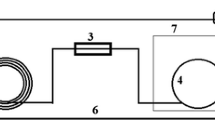Abstract
Commercially available bee pollen from Northwestern Greece was subjected to headspace solid-phase microextraction coupled to gas chromatography/mass spectrometry (HS-SPME/GC–MS) analysis for the identification of its aroma compounds. Two different procedures were followed: (a) volatile compounds analysis of ground bee pollen and (b) volatile compounds analysis of aqueous solution (1:1, w/v) of ground bee pollen. The results showed that the volatile pattern of bee pollen was mainly dominated by aldehydes, followed by ketones, terpenoids, and minor contributions of other classes of volatile compounds. The aqueous medium affected the total volatile composition by means of increasing mainly the contribution of aldehydes to the total volatile pattern. However, aroma compounds, such as (E)-2-hexenal, γ-valerolactone, and γ-butyrolactone were not identified in the aqueous bee pollen solution. Based on the volatile compounds that were identified, the aroma profile of bee pollen may be characterized as ‘’green’, ‘’floral’’, and ‘’pleasant’’. Given the limited available literature in the analysis of volatile compounds of bee pollen and the use of bee pollen as a natural odorant, Greek bee pollen at different physical state may be proposed as a flavoring agent in different foodstuffs, depending however, on the goods of interest.


Similar content being viewed by others
References
LeBlanc BW, Davis OK, Boue S, DeLucca A, Deeby T (2009) Antioxidant activity of sonorant desert bee pollen. Food Chem 115(4):1299–1305
Nogueira C, Iglesias A, Feás X, Estevinho LM (2012) Commercial bee pollen with different geographical origins: a comprehensive approach. Int J Mol Sci 13:11173–11187
Karabagias IK, Karabagias VK, Gatzias I, Riganakos KA (2018) Bio-functional properties of bee pollen: the case of “bee pollen yoghurt.” Coatings 8(12):423
Denisow B, Denisow-Pietrzyk M (2016) Biological and therapeutic properties of bee pollen: a review. J Sci Food Agric 96:4303–4309
Coe P (2007) Bee bread in apitherapy. J Am Apith Soc 14:12–16
Thorp RW (2000) The collection of pollen by bees. Pl Syst Evol 222:211–223
Kaškonienė V, Kaškonas P, Maruška A (2015) Volatile compounds composition and antioxidant activity of bee pollen collected in Lithuania. Chem Pap 69(2):291–299
Estevinho LM, Rodrigues S, Pereira AP, Feás X (2012) Portuguese bee pollen: Palynological study, nutritional and microbiological evaluation. Int J Food Sci Technol 47:429–435
Čeksteryté V, Kurtinaitiené B, Balžekas J (2013) Pollen diversity in honey collected from Lithuania’s protected landscape areas. Proc Estonian Acad Sci 62:277–282
Karabagias IK, Badeka A, Kontakos S, Karabournioti S, Kontominas MG (2014) Characterization and classification of Thymus capitatus (L.) honey according to geographical origin based on volatile compounds, physicochemical parameters and chemometrics. Food Res Int 55:363–372
Dimou M, Thrasyvoulou A (2007) Seasonal variation in vegetation and pollen collected by honey bees in Thessaloniki. Greece Grana 46(4):292–299
Dimou M, Tananaki C, Liolios V, Thrasyvoulou A (2014) Pollen foraging by honey bees (Apis mellifera L.) in Greece: botanical and geographical origin. J Apic Sci 58(2):11–23
Graikou K, Kapeta S, Aligiannis N, Sotiroudis G, Chondrogianni N, Gonos E, Chinou I (2011) Chemical analysis of Greek pollen-Antioxidant, antimicrobial and proteasome activation. Chem Central J 5:33
Bogdanov S (2004) Quality and standards of pollen and beeswax. Apiacta 38:334–341
Ricciardelli D’Albore G (1997) Textbook of melissopalynology. Apimondia Publishing House, Bucharest
Karabagias IK (2018) Volatile metabolites or pollen characteristics as regional markers of monofloral thyme honey? Sep Sci Plus 1(2):83–92
NIST (2005) National Institute of Standards and Technology. J. Wiley & Sons Ltd., West Sussex
Louveaux I, Maurizio A, Vorwohl G (1978) Methods of melissopalynology. Bee World 59(4):139–157
Berger RF (2007) Flavours and fragrances. Chemistry, bioprocessing and sustainability. Springer, Berlin Hridelberg
Vose J, Tighe T, Schwartz M, Buel E (2001) Detection of gamma-butyrolactone (GBL) as a natural component in wine. J Forensic Sci 46(5):1164–1167
Cserháti T, Forgács E (2003) Encyclopedia of food sciences and nutrition (2nd ed.). In: Flavor (Flavour) Compounds, Structures and Characteristics. Academic Press, pp 2509–2517
Stahl-Biskup E, Inert F, Holthuijzen J, Stengele M, Schulz G (1993) Glycosidically bound volatiles-a review 1986–1991. Flav Fragr J 8:61–81
Belitz HD, Grosch W, Schieberle P (2009) Food chemistry (4th ed.), Berlin: Springer
Kaškonienė V, Venskutonis PR, Čeksterytė V (2008) Composition of volatile compounds of honey of various floral origin and beebread collected in Lithuania. Food Chem 111:988–997
Castro-Vázquez L, Díaz-Maroto MC, González-Viñas MA, Perez-Coello MS (2007) Aroma composition and new chemical markers of Spanish citrus honeys. Food Chem 103:601–606
Von Der Ohe W, Persano Oddo L, Piana ML, Morlot M, Martin P (2004) Harmonized methods of melissopalynology. Apidologie 35:18–25
Funding
The present study was not funded.
Author information
Authors and Affiliations
Corresponding author
Ethics declarations
Conflict of interest
The authors declare that they have no conflict of interest.
Research involving human participants and/or animals
This article does not contain any studies with human or animal subjects.
Additional information
Publisher's Note
Springer Nature remains neutral with regard to jurisdictional claims in published maps and institutional affiliations.
Rights and permissions
About this article
Cite this article
Karabagias, I.K., Karabagias, V.K., Karabournioti, S. et al. Aroma identification of Greek bee pollen using HS-SPME/GC–MS. Eur Food Res Technol 247, 1781–1789 (2021). https://doi.org/10.1007/s00217-021-03748-4
Received:
Revised:
Accepted:
Published:
Issue Date:
DOI: https://doi.org/10.1007/s00217-021-03748-4




